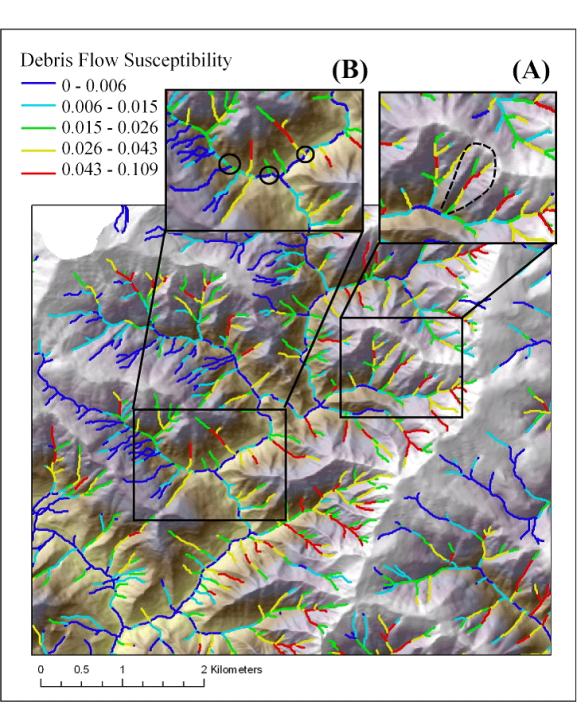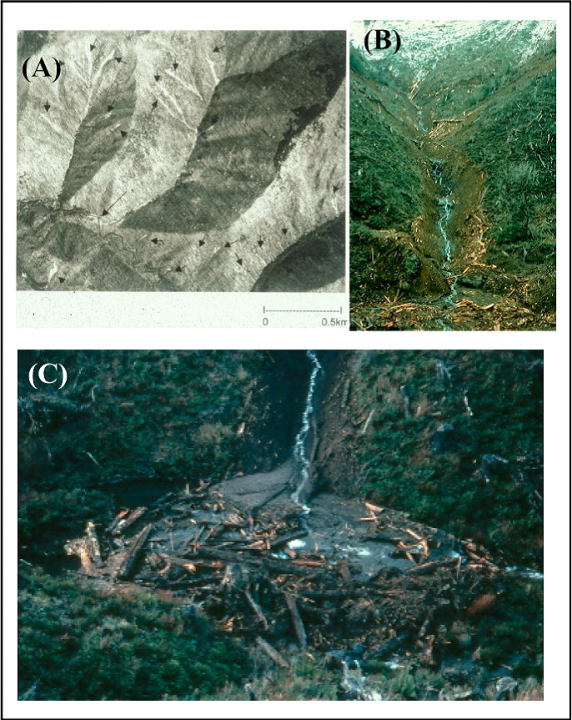NetMap's Watershed Assessment
Watershed Attribute: The susceptibility of channels to debris flow movement, scour and deposition, in terms of probability; an empirical model (Miller and Burnett 2008). Predictions include debris flow susceptibility across entire river networks, focusing on headwater streams, and debris flow susceptibilities in mainstem (fish bearing) channels at headwater tributary junctions (e.g., likely areas of debris flows impacts from steeper headwater channels).
The model is most applicable to the Oregon Coast Range; however, it utilizes topographic information that has been found to be relevant to debris flow movement in other terrains (Swanson and Lienkaemper 1978, Hungr et al. 1984, Benda and Cundy 1990, Fannin and Rollerson 1993, Fannin and Wise 2001). In all landscapes, the debris flow predictions should be considered as a screening tool. Field measurements and on the ground surveys are needed to make more accurate predictions.
Data Types: Line (in channel).
Grids (rasters)
Field Name: P_DF_AVE;
Units: Probability (0-1). The modeled relative spatial frequency of debris flow scour and deposition (and traversal, neither scour or deposition). For example, all reaches with the same modeled P_DF_AVE value have similar physical characteristics found empirically related to debris-flow occurrence (number of landslide sources, the length, steepness, and confinement of the potential debris-flow tracks leading from those landslide source areas to the reach). The P_DF_AVE value reflects the relative proportion of similar reaches mapped with debris-flow effects. We expect, therefore, out of 1000 reaches with a P_DF_AVE value of 0.02, we should find twice as many with evidence of debris-flow deposition or scour than in 1000 reaches with a P_DF_AVE value of 0.01. Hence, the model output provides a relative likelihood of debris flow potential in any stream reach, relative to all other similar stream reaches in a landscape. Although the model is calibrated using a population of stream segments following a major (1996) landslide triggering storm in the Oregon Coast Range, it is assumed that the relative likelihood of debris flows found in that case can be applied to other landscapes where debris flows are driven by similar topographic and climatic controls.
NetMap Level 1 Module/Tool: Mass Wasting/Slope Stability
Figure 1. Photographs of debris flows in the Pacific Northwest. (A) Post fire debris flows originating from steep and convergent areas and traveling through headwater streams in western Oregon. (B) A debris flow in a logged area in northwest Washington. (C) Debris flow deposit within a larger, fish bearing stream, Oregon Coast Range.
Model Description
Refer to full published paper for more details (Miller and Burnett 2008). A debris flow is defined as a highly mobile slurry of soil, rock, vegetation and water that can travel many hundreds of meters from its point of initiation through steep (more than 5 degrees gradient) and confined mountain channels (Figure 1). Debris flows are initiated by liquefaction of landslide material concurrently with failure or immediately thereafter as the soil mass and reinforcing roots break up. Debris flows contain 70 to 80 percent solids and only 20 to 30 percent water by volume. Entrainment of additional sediment and organic debris in first- and second-order channels can increase the volume of the original landslide by 1000 percent or more, enabling debris flows to become more destructive as their volume increases with distance traveled (Benda and Cundy, 1990). Debris flows typically stop at valley floors. Other names given to debris flows include debris torrents, sluice outs and mud flows.
The landslide density and delivery models (see Shallow Landslide and Landslide Hazard Proportion Attributes in the Level 1 Assessemtn) are used to calculate the relative susceptibility for direct debris-flow impacts to stream channels in a parameter called Debris Flow Susceptibility - Reaches (Figure 2). Generic erosion potential or landslide density translates to a probability of finding a landslide within any DEM pixel area. We treat this as a relative susceptibility for debris-flow initiation PI. From each pixel with a nonzero landslide density, we trace the downslope flow path defined by elevation points in the DEM. For each pixel along this flow path we calculate a delivery probability PD. For each channel junction encountered, we calculate a probability PJ that the debris flow continues through the junction. For each downslope pixel, the probability for debris-flow delivery from a specified source pixel is the product PIPDPJ. We repeat this procedure for every DEM pixel from which we calculate the susceptibility for debris flow delivery, from any source pixel, to each channel reach.

Figure 2. Predicted debris flow susceptibilities are shown for a portion of the Wilson River basin. Downstream sequences of susceptibilities in headwater streams (A) can be used to differentiate one debris flow prone headwater stream from another (low-high might warrant more caution compared to high – low). The susceptibility of headwater streams immediately above a larger, fish bearing channel (B) can also be used to differentiate debris flow potential and possible impacts to larger channels. The downstream sequence of predicted susceptibilities can be used to estimate the likelihood of debris flows reaching a specified channel segment, such as fish habitat. For example, a headwater - upstream to downstream sequence debris flow susceptibility of low – high – low would be less of a concern compared to the sequence of low – moderate – high or moderate – high or simply overall high (A). In addition, one should focus on the predicted debris flow susceptibility of the segment located immediately upstream of the low- to high-order debris flow prone confluence. Headwater segments with high susceptibility immediately upstream of the confluence with a larger fish-bearing stream is of more concern compared to headwater segments with a lower susceptibility ( B).
Ecological Implications
Debris flows are a significant component of sediment budgets in many mountain landscapes (Dietrich and Dunne 1978; Swanson et al. 1982; Wohl and Pearthee 1991) and they can cause erosion to be highly episodic (Benda and Dunne 1997a; Kirchner et al. 2001). In certain landscapes, low-order channels prone to debris flows comprise up to 80% of a channel network, and hence network topology can influence the spatial diversity of channel and valley morphologies (Benda and Dunne 1997b). In depositional areas, debris flows construct levees (Canon and Bonny 1902); build fans at tributary junctions (Dietrich and Dunne 1978); create boulder deposits along fan margins (Benda 1990; Wohl and Pearthree 1991); form ponds at fan constrictions (Everest and Meehan 1981); create wide valley floors (Grant and Swanson 1995); force channel meanders (Benda 1990); and spates of debris flows can lead to widespread channel aggradation and formation of terraces (Wohl and Pearthee 1991; Robert and Church 1986; Miller and Benda 2000). In addition, debris flows can incorporate logs and whole trees that have accumulated in low-order channels over decades to centuries and they deposit them on fans, valley floors, and in channels at low-order confluences (Swanson and Lienkaemper 1978; Hogan et al. 1998; May 1998).
Road construction and timber harvest have increased the occurrence of debris flows in some landscapes by lowering hillslope stability (Burroughs and Thomas 1977). In some cases, debris flows have increased their travel distances due to the absence of large trees along flow paths (Ketcheson and Froelich 1978; May 1998). Increased occurrence of debris flows due to timber harvest and logging roads has raised concerns about impacts to fishes and other aquatic life. Negative effects of debris flows may include immediate burial of existing habitat and direct mortality of aquatic biota; increased fine sediment in gravels onsite and downstream that suffocates fish eggs in gravel (Everest et al. 1987; Scrivener and Brownlee 1989); increased bedload transport and lateral channel movement due to heightened sediment supply that scours fish eggs; and loss of pools that reduces rearing habitat (Frissel and Nawa, 1992; Hogan et al. 1998).
Debris flows are also a “disturbance” when viewed by ecologists (Swanson et al. 1988) and the pivotal role of certain types of disturbances in maintaining productivity and diversity in aquatic ecosystems is gaining increasing recognition (Resh et al. 1988, Reeves et al. 1995). Beneficial effects of debris flows on aquatic systems include formation of ponds that become occupied by fish and beaver (Everest and Meehan 1981); release of nutrients due to buried organics in anaerobic environments (Sedell and Dahm 1984); deposition of woody debris that creates sediment wedges and forms pools (Hogan et al. 1998); deposition of boulders that trap sediments and create complex habitats (Reeves et al. 1995); formation of wider valley floors that contain larger floodplains (Grant and Swanson 1995); and increased biological productivity (Roghair et al. 2002). Spates of debris flows may also contribute to watershed-scale habitat diversity, including in riparian forests (Nierenberg and Hibbs 2000; Nakamura and Swanson 2002).
To gain a longer-term perspective on episodic erosion in humid mountain landscapes, the occurrence of debris flows and sediment routing at the scale of a sixth- order network over centuries was investigated using computer models (Benda and Dunne 1997; U. S. F. S 2002). The models predict that large volumes of sediment are concentrated in parts of the channel network, particularly near tributary junctions (i.e., low-order to high-order confluences), during infrequent periods of intense hillslope erosion following forest fires and large storms. The concentration of sediment at low-order confluences was referred to as ‘stationary sediment waves’ to extend the definition of fans to include their temporally variable influences on channel morphology and to distinguish them from waves of sediment that migrate through a network. A later theoretical analysis of the long-term mass balance of in-stream wood indicated the potential importance of debris flows as a wood recruitment agent in larger channels (Benda and Sias in press), a prediction that was preceded and motivated by field studies indicating the same conclusion (Swanson and Lienkaemper 1978; Hogan et al. 1998).
Despite the history of field work and modeling, the effects of debris flows on channel and valley morphology, particularly as it pertains to riverine ecology, remain an outstanding question. For example, none of the existing models for predicting the occurrence of shallow landslides (Montgomery and Dietrich 1994) and transport distance of debris flows (Benda and Cundy 1990, Fannin and Wise 2001) consider or predict the morphological or ecological consequences in rivers. This reduces the ability of geomorphology to effectively participate in interdisciplinary collaborations that are aimed at understanding natural environments and human alterations of them. In addition, although the potential for tributary confluences to play a key role in riverine ecology has been acknowledged, little supportive empirical information exists (Fisher 1997).


